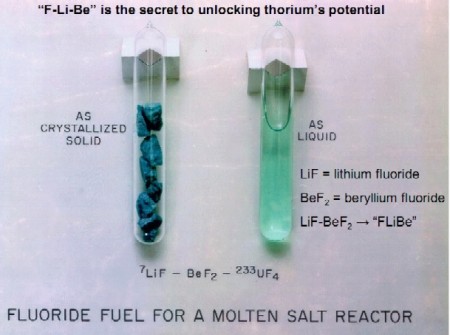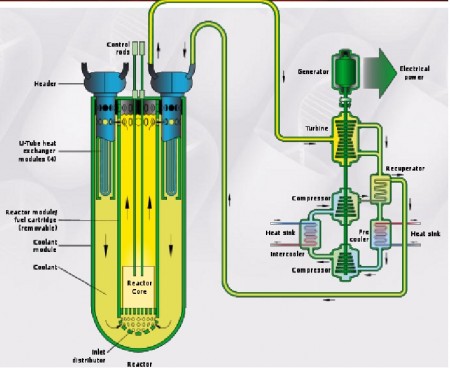May
26
Major Thorium Fuel Reactor Progress
May 26, 2011 | 8 Comments
The first firm we’ll look at is Flibe Energy, a new company that will develop small modular reactors based on liquid-fluoride thorium reactor (LFTR) technology. Flibe Energy is a new company founded by Kirk Sorensen who was (is still?) chief nuclear technologist at Teledyne Brown. The second is Thorenco LLC, founded by Charles S. Holden with support from Berkley National Laboratory and others.
Sorensen’s company is called “Flibe” from lithium fluoride (LiF) and beryllium fluoride (BeF2) that together form a solution often called “F-Li-Be”. Liquid-fluoride thorium reactors operate at high temperatures but not at high pressures because they use a chemically stable medium as the fuel and the coolant, making them much safer to operate than conventional reactors.
That temperature and pressure matter is important. In a liquid fluoride thorium reactor as hot as it is can only get so hot before the fuel melts out a plug that drains the fuel out into a diluted and non-reactive state to cool. With out the high pressures the potential for an explosion is missing. What could explode would be the steam on the other side of the heat exchanger – but that risk is in any power station from natural gas fired, to coal and on to a uranium reactor.
The other main point is the primary fuel in the solution is thorium. Thorium is abundant compared to uranium and doesn’t ratchet up in the reactor to weapons materials like plutonium. These points should, if people would pay a bit of attention, form a firm base for thorium fueled reactor progress.
The root of Sorensen’s technology comes from Nobel-Prize-winning physicist Eugene Wigner and his protégé, Alvin Weinberg, who attempted to convince the US government to research the surpassing potential of thorium after World War II. In 1955, Weinberg took charge of the Oak Ridge National Laboratory in Tennessee and began a personal campaign to try to realize the benefits of thorium. Under his leadership, two prototype nuclear reactors were built that demonstrated key technologies needed to bring thorium energy generation to reality.
Many believe, with good reason, that the lithium fluoride and beryllium fluoride salt fission reactor is the ideal medium for nuclear chemical processing and reactor operation. It is chemically stable, nearly invisible to neutrons, and impervious to radiation damage, unlike almost every other nuclear fuel. A flibe-designed reactor carries large amounts of heat at low pressures, leading to small, compact, and safe designs for nuclear reactors.
Thorenco LLC is proposing small transportable 50-megawatt-thermal thorium converter reactors for multiple uses: producing electricity and low-cost, high-temperature steam for process industrial heat. The high-temperature steam can be used for extraction of oil from tar sands, or desalinating, purifying, and cracking water. The reactor’s fuel matrix can be “tuned” to provide the right output for each particular work process.
The Thorenco designed core in the newest design is a short wide cylinder at about 140 centimeters (56 inches) in diameter and 50 centimeters (20 inches) tall. That size makes for portability, such that it can be brought to remote locations to a work site and supply heat and electricity there without dependence on long-distance transmission lines and moved, as conditions require. The small size would be factory-built and transported to its destination, “plugged in” to a deep underground containment structure, and put to work quickly. The core can be shipped back to the factory when the fuel needs to be changed.
The Thorenco fuel is quite different from the typical liquid fluoride thorium fuel. Thorenco would use fissile uranium-235 as a source of ignition neutrons and a mix of thorium tetrafluoride in a beryllium fluoride molten salt, which dispersed in an inert metal matrix covered by Holden’s Patent Cooperation Treaty application, and is pumped in circulation. The metal matrix is a solid-state metal alloy composed of four materials. The thorium and uranium fuel particles are embedded in the alloy, which both slows and moderates the fissioning process. There are moderating materials dispersed in the alloy along with the actinide particles. Using the metallic alloys as moderators (instead of the water used in other thorium reactor designs) allows Thorenco’s reactor to operate in a more energetic neutron spectrum so that its core can have a long life.
The Thorenco design with its moderator built in makes the self-regulating reactor’s fuel term to operate for 10 years without needing refueling.
These two plans put a new energy into the U.S. thorium fueled fission business. With India and of late China, racing to bring reactors to market, it’s not a moment too soon. The problem still lies in getting some motion out of the U.S. government’s regulatory apparatus.
Getting public acceptance going isn’t going to be so hard. The big issues, exploding and throwing out huge plumes of radioactivity, meltdowns burning holes in the planet, and weapons proliferation just aren’t applicable in any worthwhile way. That’s not to say those kinds of fear mongering aren’t going to happen, its just that the audience could be limited to the fewest intellectually lacking or emotionally vulnerable with a little honesty from industry, government and the media.
While starting companies isn’t technology news, and the ideas from these two firms isn’t new, the backing of the two firm is worth noting and that they are active now is cause for some celebration. Congratulation to all involved and thanks to Brian Wang and EnergyFromThorium.com for getting the word out.
Comments
8 Comments so far




Nuclear power isn’t the problem.
The problem is with the reactors we’ve been using to produce it. If the reactors at Fukushima had been Liquid Fluoride Thorium Reactors (LFTRs) they wouldn’t have had a disaster on their hands.
1. Liquid-fuel reactor technology was successfully developed at Oak Ridge National Labs in the 1960s. Although the test reactor worked flawlessly, the project was shelved, a victim of Cold War strategy. But LFTRs have been gathering a lot of attention lately, particularly since the tragic events in Japan.
2. A LFTR is a completely different type of reactor. For one thing, it can’t melt down. It’s physically impossible. And since it’s air-cooled, it doesn’t have to be located near the shore. It can even be placed in an underground vault. A tsunami would roll right over it, like a truck over a manhole cover.
3. Imagine a kettle of lava that never boils. A LFTR uses liquid fuel⎯nuclear material dissolved in molten fluoride salt. Conventional reactors are atomic pressure cookers, using solid fuel rods to super-heat water. That means the constant danger of high-pressure ruptures and steam leaks. But liquid fuel can always expand and cool off.
4. LFTRs don’t even use water. Instead, they heat a common gas like CO2 to spin a turbine for generating power. So if a LFTR does leak, it’s not a catastrophe. Just like lava, the molten salt immediately cools off, quickly becoming an inert lump of rock.
5. LFTRs burn Thorium, a mildly radioactive material as common as tin and found all over the world. We’ve already mined enough raw Thorium to power the country for 400 years. It’s the waste at our Rare Earth Element mines.
6. LFTRs consume fuel so efficiently that they can even use the spent fuel from other reactors, while producing a miniscule amount of waste themselves. In fact, the waste from a LFTR is virtually harmless in just 300 years. (No, that’s not a typo.) Yucca Mountain is obsolete. So are Uranium reactors.
7. LFTR technology has been sitting on the shelf at Oak Ridge for over forty years. But now the manuals are dusted off, and a dedicated group of nuclear industry outsiders is ready to build another test reactor and give it a go.
Will it work? If it doesn’t, we’ll have one more reactor to retire. But if it does work⎯and there is every reason to believe that it will⎯the LFTR will launch a new American paradigm of clean, cheap, safe and abundant energy.
Let’s build one and see!
One major sticking point for liquid thorium reactors is: the Business Model.
Currently, nuclear companies sell machined uranium fuel rods in perpituity to the atomic power plants. But, liquid thorium is not machined. It’s just a refined chemical. It can be purchased in bulk. And, the nuclear companies do not have that ongoing revenue stream.
i tkink we have to at the rossi E-cat reactor!
[…] the issues and hope to raise private investment capital and have working reactors as soon as 2015: https://newenergyandfuel.com/http:/newenergyandfuel/com/2011/05/26/major-thorium-fuel-reactor-progres… This type of technology is likely to produce a direct alternative to large electricity generation […]
Respected sir,
I am very happy to know the concept of running a run with the fuel as radio active element Thorium. It shall have to bring a major change in transportation sector, as so many various kinds of transport vehicles shall use this kind of technology.
Today we need so many energy requirements at economic price. Most of the countries do not have sufficient electricity for their basic requirements i.e. in Agriculture, small industries etc. Not having sufficient current supply for water pumps (i.e. tube well, open well etc. for farming), farmers face so many difficulties. So there shall be a solution for sufficient electricity supply with this Thorium.
Thanks & Regards,
Sriram Srinivas Reddy,
+91 – 9492791089.
I have been an advocate of these reactors since I first read kirks speech on it I am glade to see that private companies are working to make this a reality it will work it has been proven and will revolutionize power generation if these companies go public I will buy stock
“Bull shit baffle brains”;
1. There is no shortage of anything except brains
2. I have run engine on water 400% over unity. Energy crisis solved.
3. I have made medicine curing any virus in your body including DNA cancer, also malaria, etc.
4. All 1800’s science so don’t be alarmed we will get Thorium on the map.
The big question is; will the (edited) that are playing god over our money allow us ?
Jan: I have a grid connection that will allow you to commercialize your over unity invention under the radar. Are you interested? Please email me at roylong@sbcglobal.net.
Thanks.